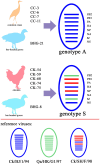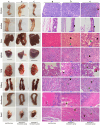Diversity of genotypes and pathogenicity of H9N2 avian influenza virus derived from wild bird and domestic poultry
- PMID: 38974026
- PMCID: PMC11225357
- DOI: 10.3389/fmicb.2024.1402235
Diversity of genotypes and pathogenicity of H9N2 avian influenza virus derived from wild bird and domestic poultry
Abstract
Introduction: The H9N2 subtype is a predominant avian influenza virus (AIV) circulating in Chinese poultry, forming various genotypes (A-W) based on gene segment origins. This study aims to investigate the genotypic distribution and pathogenic characteristics of H9N2 isolates from wild birds and domestic poultry in Yunnan Province, China.
Methods: Eleven H9N2 strains were isolated from fecal samples of overwintering wild birds and proximate domestic poultry in Yunnan, including four from common cranes (Grus grus), two from bar-headed geese (Anser indicus), and five from domestic poultry (Gallus gallus). Phylogenetic analysis was conducted to determine the genotypes, and representative strains were inoculated into Yunnan mallard ducks to assess pathogenicity.
Results: Phylogenetic analysis revealed that five isolates from domestic birds and one from a bar-headed goose belong to genotype S, while the remaining five isolates from wild birds belong to genotype A. These bird-derived strains possess deletions in the stalk domain of NA protein and the N166D mutation of HA protein, typical of poultry strains. Genotype S H9N2 demonstrated oropharyngeal shedding, while genotype A H9N2 exhibited cloacal shedding and high viral loads in the duodenum. Both strains caused significant pathological injuries, with genotype S inducing more severe damage to the thymus and spleen, while genotype A caused duodenal muscle layer rupture.
Discussion: These findings suggest that at least two genotypes of H9N2 are currently circulating in Yunnan, and Yunnan mallard ducks potentially act as intermediaries in interspecies transmission. These insights highlight the importance of analyzing the current epidemiological transmission characteristics of H9N2 among wild and domestic birds in China.
Keywords: H9N2 AIV; bar-headed goose; common crane; genotype A; genotype S; pathologic analysis; phylogenetic analysis.
Copyright © 2024 Yang, Ji, Yang, Zhang, Yin, Dai, Wang and Li.
Conflict of interest statement
The authors declare that the research was conducted in the absence of any commercial or financial relationships that could be construed as a potential conflict of interest.
Figures





Similar articles
-
Rapid evolution of low-pathogenic H9N2 avian influenza viruses following poultry vaccination programmes.J Gen Virol. 2011 Jan;92(Pt 1):36-50. doi: 10.1099/vir.0.024992-0. Epub 2010 Sep 22. J Gen Virol. 2011. PMID: 20861321
-
Phylogenetic analysis and assessment of the pathogenic potential of the first H9N2 avian influenza viruses isolated from wild birds and Lagoon water in Tunisia.Virus Res. 2022 Dec;322:198929. doi: 10.1016/j.virusres.2022.198929. Epub 2022 Sep 17. Virus Res. 2022. PMID: 36126884
-
Avian influenza surveillance reveals presence of low pathogenic avian influenza viruses in poultry during 2009-2011 in the West Bengal State, India.Virol J. 2012 Aug 7;9:151. doi: 10.1186/1743-422X-9-151. Virol J. 2012. PMID: 22867041 Free PMC article.
-
Origin and evolution of highly pathogenic H5N1 avian influenza in Asia.Vet Rec. 2005 Aug 6;157(6):159-64. doi: 10.1136/vr.157.6.159. Vet Rec. 2005. PMID: 16085721 Review.
-
Sporadic occurrence of H9N2 avian influenza infections in human in Anhui province, eastern China: A notable problem.Microb Pathog. 2020 Mar;140:103940. doi: 10.1016/j.micpath.2019.103940. Epub 2019 Dec 18. Microb Pathog. 2020. PMID: 31863839
Cited by
-
Molecular cloning and characterization of duck CD83 and its effect on H9N2 avian influenza viruses replication.Poult Sci. 2025 Jul 13;104(10):105570. doi: 10.1016/j.psj.2025.105570. Online ahead of print. Poult Sci. 2025. PMID: 40729815 Free PMC article.
-
Phylogenetic and ecological drivers of the avian lung mycobiome and its potentially pathogenic component.Commun Biol. 2025 Apr 19;8(1):634. doi: 10.1038/s42003-025-08041-8. Commun Biol. 2025. PMID: 40253508 Free PMC article.
-
Development of an experimental model using cold stress to assess the pathogenicity of two Moroccan AI H9N2 isolates from 2016 and 2022 in commercial broiler chickens.PLoS One. 2025 Apr 4;20(4):e0320666. doi: 10.1371/journal.pone.0320666. eCollection 2025. PLoS One. 2025. PMID: 40184370 Free PMC article.
References
-
- Fereidouni S. R., Starick E., Grund C., Globig A., Mettenleiter T. C., Beer M., et al. . (2009). Rapid molecular subtyping by reverse transcription polymerase chain reaction of the neuraminidase gene of avian influenza A viruses. Vet. Microbiol. 135, 253–260. 10.1016/j.vetmic.2008.09.077 - DOI - PubMed
LinkOut - more resources
Full Text Sources

